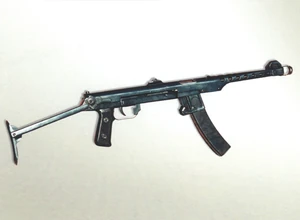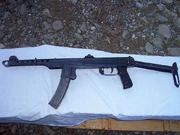| PPS | |
|---|---|
 PPS-43 with stock extended | |
| Type | Submachine Gun |
| Place of origin | Soviet Union |
| Service history | |
| In service | 1942–present |
| Used by | Communist forces |
| Production history | |
| Designer | A. I. Sudayev |
| Designed | 1942 |
| Produced | 1942–1968 (USSR) |
| Variants | PPS-42, PPS-43, M/44, PPS wz. 1943/1952, Type 43 |
| Specifications | |
| Weight | PPS-42: 2.95 kg (Script error: No such module "Math". lb) PPS-43: 3.04 kg (Script error: No such module "Math". lb) |
| Length | PPS-42: 907 mm (Script error: No such module "Math". in) stock extended / 641 mm (Script error: No such module "Math". in) stock folded PPS-43: 820 mm (Script error: No such module "Math". in) stock extended / 615 mm (Script error: No such module "Math". in) stock folded |
| Barrel length | PPS-42: 273 mm (Script error: No such module "Math". in) PPS-43: 243 mm (Script error: No such module "Math". in) |
| Cartridge | 7.62x25mm Tokarev |
| Action | Blowback, open bolt |
| Rate of fire | 600-900 rounds/min (cyclic rate) 100 rounds/min (effective rate) |
| Muzzle velocity | Approx. 500 m/s (Script error: No such module "Math". ft/s) |
| Effective range | 200 m |
| Feed system | 35-round detachable box magazine |
| Sights | Flip rear sight, fixed blade front sight |
The PPS (Russian: ППС - "Пистолет-пулемёт Судаева" or "Pistolet-pulemjot Sudaeva", in English: "Sudaev's submachine-gun") was a family of Soviet submachine guns chambered in 7.62x25mm Tokarev, developed by Alexei Sudayev as a low-cost personal defense weapon for reconnaissance units, vehicle crews and support service personnel.[1]
The PPS and its variants were used extensively by the Red Army during World War II and were later adopted by the armed forces of several countries of the former Warsaw Pact as well as its many African and Asian allies.
History[]
The PPS was created in response to a Red Army requirement for a compact and lightweight weapon with similar accuracy and projectile energy to the Soviet PPSh-41 submachine gun widely deployed at the time, with reduced rate of fire, produced at lower cost and requiring less manpower, particularly skilled manpower. During design, emphasis was placed on simplifying production and eliminating most machining operations; most of the weapon's parts were sheet-steel stamped.[1] These measures reduced the number of machined components to a bare minimum, cutting down machining time by more than half, to 2.7 hours of machining instead of 7.3 hours for the PPSh-41. There were also savings of over 50% in raw steel usage, down to 6.2 kg instead of 13.9 kg, and fewer workers were required to manufacture and assemble the parts.
Prototypes were evaluated successfully during the spring of 1942; the firearm was accepted into service later that year as the PPS-42 (Russian: Пистолет-пулемёт Судаева—ППС or Pistolet Pulemyot Sudayeva model of 1942).[1] The weapon was put into small-scale production during the Siege of Leningrad; mass production did not commence until early 1943 at the Sestroryetsk Arsenal (over 45,000 weapons were produced before being replaced by the improved PPS-43).[1] The improvements to production efficiency allowed the Soviets to increase monthly submachine gun output from 135,000 units to 350,000 weapons.
Design details[]
Operating mechanism[]
The PPS was an automatic blowback-operated weapon that fired from an open bolt.[1] The bolt was cylindrical in shape and contained a spring-loaded claw extractor, which pulled the empty case out of the chamber and passed it to the fixed ejector housed in the lower receiver. The charging handle was integral to the bolt and was located on the right side; it reciprocated during firing. The PPS originally had a fixed but replaceable firing pin, held in place by the extractor spring. Pulling the trigger released the bolt, which moved forward, stripping a round from the magazine, chambering it and striking the primer in one motion.
Features[]
The PPS had a trigger mechanism that allowed only fully automatic fire and a manual safety that secured them against accidental discharges. When in the "safe" position (engaged by sliding a metal bar forward of the trigger guard), both the bolt and trigger were disabled. [1]
The weapon was fed from curved 35-round box magazines. They were not interchangeable with magazines used in the PPSh-41, nor could the gun use drum magazines. It was chambered for the 7.62x25mm Tokarev M1930 pistol cartridge.[1]
The submachine gun's rifled barrel (with 4 right-hand grooves) was mounted in a perforated sheet metal heat guard and was equipped with a crude muzzle brake, consisting of a strip of steel bent into a U-shape that deflected exiting muzzle gases to the sides and backwards, thus compensating for recoil.[1]
A folding stock was attached to the receiver with a spring-loaded catch button on the left side. The stock folded up and over the receiver top cover and the weapon could be fired in this arrangement. The submachine gun also had a pistol grip but was not provided with a forward grip as the magazine well was intended to fulfil this role.[1] The PPS was usually supplied with two magazine pouches, an oil bottle, bore brush and sling.
Sights[]
The PPS was fitted with a set of open-type iron sights consisting of a fixed front post protected from impact by two sheet metal plates and a flip rear sight with two pivoting notches, for firing at 100 and 200 m.[1]
Variants[]

A Chinese-made Type 54 variant.
Towards the middle of 1943 the modernized PPS-43 entered production; efforts were made to improve manufacturing and safety.[1] The ventilated heat shield was integrated with the upper receiver cover, both the barrel and shoulder stock were shortened, the stock's locking mechanism was simplified, the casing ejector was moved to the rear of the recoil spring guide rod, the magazine well angle was increased in the receiver in order to enhance feeding reliability and the safety was improved to block the trigger and lock the bolt in either the open or closed positions.[1]
Outside of the Soviet Union, the PPS was license-produced in Poland (from 1948) and the People's Republic of China (Type 54).[1] Several variants were made based on the PPS-43, including a training version built in Poland, chambered for the .22 Long Rifle rimfire cartridge (fed using standard PPS-43 magazines but modified with an aluminum reduction insert) and the Finnish M/44 submachine gun. The M/44 was a modified copy with minor differences to the original PPS-43. It fired the 9x19mm Parabellum pistol round and accepted box magazines from the Carl Gustav SMG or drum magazines from the Suomi M/31.[1]
In the early 1950s Poland developed a modified version of the PPS-43, known as the PPS wz. 1943/1952 that replaced the folding metal stock with a fixed wooden buttstock.[2] This was mounted to the receiver end plate using two inserts and the receiver take-down hook was bent downwards to accommodate the change. The buttstock has a compartment carved inside of it that contains a standard cleaning kit; the side of the butt has a sling loop. This modification was meant to increase the accuracy of the PPS submachine gun, but minimal gains in accuracy were offset by the increase in weight and size of the PPS wz. 43/52 in comparison to the original PPS-43. Between 1952–1955, the Łucznik Arms Factory in Radom built approximately 111,000 PPS submachine guns.
In 1953, the West German border guards (Bundesgrenzschutz) adopted the Spanish-made DUX-53 and DUX-59 submachine guns, copied from the PPS-43 by way of the Finnish M/44. The Vietnamese K-50M also borrowed elements from the PPS design, while in the 1950s, Hungary combined basic features of the PPS-43 with the bolt safety of the PPSh-41 in the unsuccessful M53.
In 2010, Pioneer Arms, of Radom, Poland, began producing a semi-auto only version of the PPS design, called the PPS-43c.[3] The gun, sold with its stock fixed in the closed position, is legally considered a pistol. The gun is of a closed bolt, hammer fired, blow back operated design.
References[]
Bibliography[]
Script error: No such module "citation/CS1".
- Invalid language code. Script error: No such module "citation/CS1".
External links[]
Script error: No such module "Navbox".